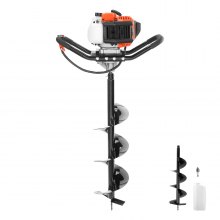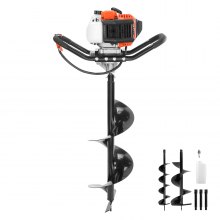Beneath the Surface: VEVOR Exploring the Mechanics Behind Earth Augers
The earth beneath consoles much more than the human mind can fathom and can take even more. From fence making to tree planting, there have always been necessities to dig the earth for various reasons. However, while the traditional earth-digging methods have served the purposes, earth augers have made the job more effective and time-efficient.
Earth augers also reduce the physical strains on the operator and improve the overall quality of the hole dug. VEVOR, recognizing how much more the earth beneath can take, delves into an adventure of high-quality earth augers.
How Do Earth Augers Work?
Earth augers use mechanical energy to penetrate the soil and create holes efficiently and quickly. The components and operational components of earth augers give a direct insight into their overall working mechanism.
Earth augers derive power from gas engines, electrical motors, or hydraulic systems. Gas-powered earth augers are portable with high-torque output, making them suitable for industrial and heavy-duty tasks.
Electric drills are suitable for smaller operations, and they are quieter. They are also only ideal for places with a constant supply of electricity. Hydraulic augers use a hydraulic system to discharge immense power, making it suitable for industrial uses.
The drilling mechanism of an earth auger is made up of a spinning shaft with cutting blades or bits attached to the bottom end. The design of these blades or bits varies according to the soil type and intended purpose.
Spiral blades are useful for removing particles from softer soils, such as loam and clay. In contrast, rocky or compacted soils may require teethed bits or specialized drilling heads to cut through difficult terrain.
When the power source is turned on, it sends energy to the drill's spinning shaft, which causes the cutting blades or bits to turn. As the blades make contact with the earth, they produce a hole by scooping out material and lifting it to the surface.
You can control the depth and diameter of the hole you are drilling by adjusting the auger’s height and rotation speed.
Different Types Of Earth Augers
Earth augers come in different types with various features, advantages, and limitations. The choice of auger for each use depends on the soil type, budget, and available power source. Therefore, you must understand the different types of augers to select the most appropriate one.
Handheld Earth Augers
Handheld augers are manually operated and are suitable for lightweight tasks. Therefore, you can find them in applications like gardening, landscaping, or small-scale digging. They are composed of a single shaft with a handle at the top. They also have a cutting blade or bit at the bottom for the digging process. Handheld augers are portable, lightweight, and convenient, making them perfect for homeowners and professionals working on minor tasks.
Gas-Powered, Electric, and Hydraulic Earth Augers
This classification is based on the handheld augers’ power source. Handheld augers can use pneumatic gas, hydraulic system, or electrical energy to power themselves.
Tractor-Mounted Earth Augers
Tractor-mounted earth augers are specially designed attachments that can be fitted to tractors. They are commonly used in farming, landscaping, and construction applications requiring high precision and power. They can drill deep, wide holes to plant crops, put fence posts, and excavate irrigation channels.
Tips For Safe Usage Of Earth Augers
The right use of earth augers is essential to minimize the risks of accidents and injuries during operation. Whether you are a professional or DIY operator, safe usage is essential.
Check For Obstructions And Underground Utilities
Clear any obstructions like rocks, debris, and dirt from the ground before digging. This can prevent them from flying into you or the auger during the process. Also, remove loose jewelry or clothes that can get in your way during the augering process.
Furthermore, call the local authorities and utility companies to locate and mark underground utilities beforehand. This prevents you from digging them up or damaging them, getting you in trouble with the authorities. The underground utilities can include gas pipes, electrical wiring, sewer lines, or water pipes.
Choose The Appropriate Auger Bit
Choose a suitable auger bit for your operation. Consider the soil conditions and the work at hand when choosing one, as different soil types necessitate different bits. For instance, spiral blades are better for gentler soils and teethed bits for rocky or compacted dirt. Using the correct bit increases efficiency while lowering the risk of equipment damage or operator injury.
Start The Engine And Shut It Down Safely
Start the auger’s operation correctly by ensuring it is in a neutral position before starting the engine. Also, set the throttle at the lowest speed and allow the engine to warm up before engaging the auger bits.
Similarly, shut it down safely by disengaging the auger drill and allowing it to come to a complete stop before shutting off the engine. Please wait until the auger bit stops rotating before removing it from the ground. Check and follow the manufacturer’s instructions when purring on or shutting down the auger bits.
Why Choose VEVOR?
Earth augers are made for tough excavation tasks. Therefore, you cannot compromise on getting the best one possible. In other words, VEVOR’s earth augers are your best bet for a long-lasting investment. VEVOR ensured the sturdy construction of these earth augers, ensuring a long-lasting performance for professionals, homeowners, and hobbyists.
They feature innovative designs that incorporate high-tech engineering and cutting-edge innovations. VEVOR designs its earth augers for precision, durability, and efficiency. With our dedication to customer support, you get a comprehensive warranty and great after-support services. Furthermore, our earth augers are competitively priced, as they are some of the most affordable in the market.
Essentially, VEVOR’s earth augers are your one-in-all packages for reliability and efficiency.
FAQs About Earth Augers
Can I rent an earth auger instead of buying one?
Indeed, many equipment rental businesses provide short-term rentals for earth augers. Renting can be a financially sensible choice, particularly for a one-time project or occasional use. But if you think you'll need an auger often, it is more cost-effective to buy one.
Can earth augers be used to dig through rocks or hard soil?
Some earth augers are outfitted with cutting bits or blades specifically made for drilling through rocks or hard soil. But it's crucial to pick the appropriate auger type and ensure it works with the soil conditions you'll be working with.
What size of earth auger do I need?
The size of the earth auger required is determined by the diameter and depth of the holes to be drilled, as well as the type of soil being drilled. To ensure optimal performance, choose an auger size that is appropriate for your unique needs.





































































































